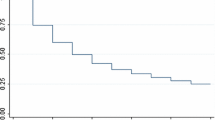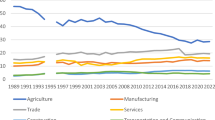Abstract
A comparative analysis on Korean manufacturing plants is performed by size of plants and sources of TFP growth are decomposed into entry, exit, and survival effects of plants, focusing on the pre- and post-crisis periods. Additional survival analyses investigate internal and external determinants of the survival of plants. The results indicate that the exit of small- and medium-sized establishments (SMEs) with higher productivity is becoming problematic in the post-crisis period. The improvements in large-scale establishments (LSEs) after the crisis appeared to occur generally in high-technology industrial sectors; SMEs in low-technology industries are suffering from a sluggish market selection process.
Similar content being viewed by others
References
Ahn, S. (2001) “Firm Dynamics and Productivity Growth: A Review of Micro Evidence from OECD Countries”, OECD Economics Department Working Paper, 297, OECD Economics Department, OECD publishing, Paris, France.
——, K. Fukao and H. U. Kwon (2005) “The Internationalization and Performance of Korean and Japanese Firms: An Empirical Analysis Based on Micro-data”, Seoul Journal of Economics, Vol. 17, pp. 439–482.
Aw, B. Y. (2002) “Productivity Dynamics of Small and Medium Enterprises in Taiwan”, Small Business Economics, Vol. 18, pp. 69–84.
——, X. Chen and M. J. Roberts (2001) “Firm-level Evidence on Productivity Differentials and Turnover in Taiwanese Manufacturing”, Journal of Development Economics, Vol. 66, pp. 51–86.
——, S. Chung and M. J. Roberts (2003) “Productivity, Output, and Failure: A Comparison of Taiwanese and Korean Manufacturers”, The Economic Journal, Vol. 113, pp. 485–510.
Baily, M. N., C. Hulten and D. Campbell (1992) “Productivity Dynamics in Manufacturing Plants”, Brookings Papers on Economic Activity: Microeconomics, Brookings Institute, Washington, D.C., pp. 187–249.
Baldwin, J. R. and W. Gu (2006) “Plant Turnover and Productivity Growth in Canadian Manufacturing”, Industrial and Corporate Change, Vol. 15, pp. 417–465.
Bank of Korea (2004) “The Source of Polarized Economy and Role of Policy”, Document for Press Release, Institute for Monetary and Economic Research, Bank of Korea. (In Korean.)
Carpenter, R. E. and B. C. Peterson (2002) “Capital Market Imperfections, High-tech Investment, and New Equity Financing”, The Economic Journal, Vol. 112, pp. F54–F72.
Cho, Y. S. (2004) “The Special Feature and Role of Comprehensive Countermeasure for Developing Competitive Power of SMEs”, Monthly KIET Industrial Economy, Vol. 71, pp. 24–36. Korea Institute for Industrial Economics and Trade. (In Korean.)
Choi, Y. H. (1996) “The Path to Modernization 1962–92”, in L. M. Branscomb and Y.-H. Kim (eds), Korea at the Turning Point: Innovation Based Strategies for Development. Westpoint, Connecticut: Praeger Press.
Cox, D. R. (1972) “Regression Models and Life Tables (With Discussion)”, Journal of the Royal Statistical Society Series B, Vol. 34, pp. 187–220.
Cressy, R. (2002) “Funding Gaps: A Symposium”, The Economic Journal, Vol. 112, pp. F1–F16.
Disney, R., J. Haskel and Y. Heden (2003) “Restructuring and Productivity Growth in UK Manufacturing”, The Economic Journal, Vol. 113, pp. 666–694.
Fisher, L. D. and D. Y. Lin (1999) “Time-Dependent Covariates in the Cox Proportional-Hazards Regression Model”, Annual Review of Public Health, Vol. 20, pp. 145–157.
Fukao, K., Y. G. Kim and H. U. Kwon (2006) “Plant Turnover and TFP Dynamics in Japanese Manufacturing”, Hi-Stat Discussion Paper Series, d06–180, Institute of Economic Research, Hitotsubashi University.
—— and H. U. Kwon (2006) “Why Did Japan’s TFP Growth Slow Down in the Lost Decade? An Empirical Analysis Based on Firm-level Data of Manufacturing Firms”, Japanese Economic Review, Vol. 57, pp. 195–228.
Good, D. H. (1985) The Effect of Deregulation on the Productive Efficiency and Cost Structure of the Airline Industry, PhD Dissertation. University of Pennsylvania.
——, M. I. Nadiri and R. C. Sickles (1997) “Index Number and Factor Demand Approaches to the Estimation of Productivity”, in H. Pesaran and P. Schmidt (eds), Handbook of Applied Econometrics: Microeconometrics, Vol. II. Oxford: Blackwell Publishers.
Gregory, G., C. Harvie and H. H. Lee (2002) “Korean SMEs in the Wake of the Financial Crisis: Strategies, Constraints and Performance in A Global Economy”, Economic Working Papers, wp02-12, School of Economics and Information Systems, University of Wollongong, NSW, Australia.
Griliches, Z. and H. Regev (1995) “Firm Productivity in Israeli Industry 1979–88”, Journal of Econometrics, Vol. 65, pp. 175–203.
Hahn, C. H. (2000) “Entry, Exit and Aggregate Productivity Growth: Micro Evidence on Korean Manufacturing”, OECD Economics Department Working Papers, 272, OECD Economics Department.
—— (2004) “Exporting and Performance of Plants: Evidence from Korean Manufacturing”, NBER Working Paper 10208.
Hakkala, K. (2004) “Corporate Restructuring and Labor Productivity Growth”, IUI Working Paper, 619, The Research Institute of Industrial Economics, Stockholm, Sweden.
Hong, K. and J.-W. Lee (2000) “Korea: Returning to Sustainable Growth?”, in W. T. Woo, J. D. Sachs and K. Schwab (eds), The Asian Financial Crisis: Lessons for a Resilient Asia. Cambridge, MA: The MIT Press.
Hoshi, T. (2006) “Economics of the Living Dead”, Japanese Economic Review, Vol. 57, pp. 30–49.
IMF (2005) “Republic of Korea: 2004 Article IV Consultation-staff Report; Staff Statement; and Public Information Notice on the Executive Board Discussion”, IMF Country Report, 05/49, International Monetary Fund, Washington, D.C.
Jwa, S.-H. and J.-H. Seo (2000) “Asian Crisis and Implications for Industrial Policies”, in: J. Choi (ed.), Asian Financial Crisis: Financial, Structural and International Dimensions. Amsterdam: JAI Press.
Kang, D. (2005) “Corporate Distress and Restructuring Policy of Korean Small and Medium sized Enterprises: Role of Credit Guarantee Scheme”, Paper presented at the 2005 KDI-KAEA conference, Korea Development Institute, 15 July 2005.
Kang, J. W. and A. Heshmati (2008) “Effect of Credit Guarantee Policy on Survival and Performance of SMEs in Republic of Korea”, Small Business Economics, (forthcoming).
Kaplan, E. L. and P. Meier (1958) “Non-parametric Estimation from Incomplete Observations”, Journal of the American Statistical Association, Vol. 53, pp. 457–481.
Keller, W. and S. R. Yeaple (2003) “Multinational Enterprises, International Trade, and Productivity Growth: Firm-level Evidence from the United States”, IMF Working Paper, WP/03/248, International Monetary Fund, Washington DC.
Kim, K.-D. (1996) “Shifting Strategies: From Cost Advantage to Superior Value”, in L. M. Branscomb and Y.-H. Kim (eds), Korea at the Turning Point: Innovation Based Strategies for Development. Westpoint, CN: Praeger Press.
Kim, H.-W. (2005) “The Profitability Improving Effects of Korean SME Policy Lending Programs”, Korea Development Review, Vol. 27, pp. 45–87. (in Korean).
Kim, J.-K. and H. L. Lee (2002) “Insolvency in the Corporate Sector and Financial Crisis in Korea”, Journal of the Asia Pacific Economy, Vol. 7, pp. 267–281.
Koo, J. and S. L. Kiser (2001) “Recovery from A Financial Crisis: The Case of South Korea”, Economic and Financial Review, Q IV, pp. 24–36.
Lee, K. W., S. H. Kim, I. C. Lee and K. H. Lee (2002) “Evaluation of IT Venture Policy and the Future Objective”, Issues on Information and Communications Policy, Vol. 14, Korea Information Strategy Development Institute. (In Korean.)
Neumann, G. R. (1997) “Search Models and Duration Data”, in H. Pesaran and P. Schmidt (eds), Handbook of Applied Econometrics: Microeconometrics, Vol. II. Oxford: Blackwell Publishers.
Nishimura, K. G., T. Nakajima and K. Kiyota (2005) “Does the Natural Selection Mechanism Still Work in Severe Recessions? Examination of the Japanese Economy in the 1990s”, Journal of Economic Behavior and Organization, Vol. 58, pp. 53–78.
OECD (2003) The Sources of Economic Growth in OECD Countries. Paris: OECD Publications.
Okada, T. and C. Y. Horioka (2008) “A Comment on Nishimura, Nakajima, and Kiyota’s ‘Does the Natural Selection Mechanism Still Work in Severe Recessions? Examination of the Japanese Economy in the 1990s’”, Journal of Economic Behavior and Organization, Vol. 67, pp. 517–520.
Salim, R. A. and K. P. Kalirajan (1999) “Sources of Output Growth in Bangladesh Food Processing Industries: A Decomposition Analysis”, The Developing Economies, Vol. 37, pp. 355–374.
Shin, Y. S. (2005) “Current Distress in SME Sector and Future Countermeasure”, Weekly Financial Brief, Vol. 14, pp. 14–19. Korea Institute of Finance. (In Korean.)
Yoshitomi, M. and ADB (Asian Development Bank) Staff (2003) Post-Crisis Development Paradigms in Asia. Tokyo: Asian Development Bank Institute.
Author information
Authors and Affiliations
Rights and permissions
About this article
Cite this article
Oh, I., Heshmati, A., Baek, C. et al. Comparative Analysis of Plant Dynamics by Size: Korean Manufacturing. JER 60, 512–538 (2009). https://doi.org/10.1111/j.1468-5876.2009.00470.x
Accepted:
Published:
Issue Date:
DOI: https://doi.org/10.1111/j.1468-5876.2009.00470.x




